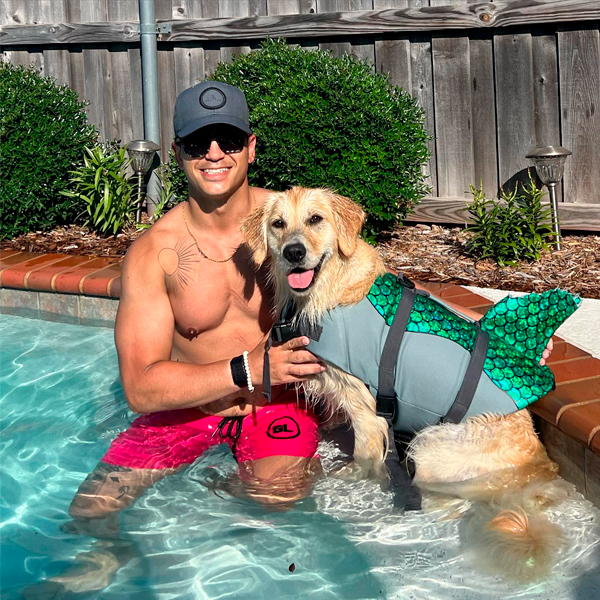The hottest time of year is back! The joy of summer is escape-the-heat road trips, which for many will include the family pet(s). The bummer of summer is the steep rise in heat-related dangers for animals and people. To keep these vacation months safe and comfortable for two- and four-legged friends, we’ll revisit some helpful tips for pet safety while driving, or just being outdoors.
When contemplating a long road trip, the first thing to ask is: does your animal pal really need to go along? Many dogs will jump right in the car, but for the anxious ones even short trips can be traumatizing, and for nearly all cats, a ten-minute trip to the vet means nonstop yowling and two days of cold-shouldering. (Yes, the destination might have something to do with that!) For these more sensitive companions, it may be kinder to leave them in their comfort zone, looked after by friends or family.
Regardless, whether you’ve committed to a cross-country drive with your pet or just habitually bring them along on errands, basic preparedness can bring peace of mind. Without safety measures, that short drive to the dog park is potentially dangerous — even lethal — for pets and people. Here’s how to keep everyone in one piece:
- Restrain your animal! The top research-supported safety rule: free-roaming pets in the car are a distraction danger. The National Distracted Driving Coalition estimates 25-30% of traffic fatalities are caused by driver distraction each year. https://usnddc.org. According to the American Automobile Association (AAA), 31% of drivers are distracted by their dogs, and 80% admit to driving frequently with pets, but only 17% use a pet restraint. Consider: in a collision, a 10-lb. dog at 50 mph exerts 500 lbs. of force, while at just 30 mph an 80-lb. dog exerts 2400 lbs.!
- Use a safety device –The ideal is a carrier or travel kennel. There are harnesses that clip to a seatbelt, but many harnesses only restrain, not prevent injury in a collision. The Center for Pet Safety www.centerforpetsafety.org tests harnesses for collision safety.
- Heads inside – a grinning dog with ears flapping out the window may look cute, but it’s dangerous. They can be sickened by gulping forced air, stung by insects, hit by objects outside, or suffer eye injury from flying debris. Sudden braking can result in neck injury or being thrown from your vehicle and struck by another.
- Never in front – like small children, animals can be injured or even killed by an airbag. The safest place for animal friends is in the back, preferably on the floor behind the passenger seat.
- Be Consistent – use the same precautions for short and long trips. Statistically, most accidents happen within 25 miles of home, often less than 10. National Highway and Traffic Safety Administration www.nhtsa.gov/risky-driving/
seat-belts - Bring a travel buddy – especially on long trips. A friend can interact with your pet, allowing you to focus on driving.
- Practice acclimation – Pet parents often avoid restraints due to animal upset. Ease them into it with short rides, gradually working up to longer ones. Also, familiarize them with being in their carrier well before attempting a drive.
- Pre-trip exercise – long walks or play sessions reduces agitation.
- Bring Soothers – ask your vet about medications for anxiety and motion sickness; pheromone sprays relieve stress; light music or white noise quiet nerves; Favorite blankets/toys – seeing or smelling familiar items from home is reassuring; Bottled Water – prevents digestive issues from unfamiliar water sources; Treats – to be given during rest breaks or by a travel friend along the way. (Avoid full meals 3-4 hours before a trip, though, to prevent motion sickness.)
Everyone knows that summer heatwaves also bring dangers for pets. A yearly heat safety refresher never goes amiss.
In the car: if their riding with you — hopefully in the back seat, where we’ve established it’s safest — be sure to angle a/c vents toward the rear of the cabin. Cover hot vinyl seats with a sheet or towel. Bring along water in case you get stuck somewhere without access. Never leave your animal unattended, even if you think you’ll only be a few minutes. Remember, within minutes the interior of a car is easily 20 degrees hotter than outdoors. Plus, in Arizona it’s illegal to leave animals unattended in vehicles and the Good Samaritan law protects people who break into them to rescue distressed pets. If you find yourself needing to do that, be sure to notify the police first, wait with the animal until they arrive unless the pet is in immediate danger.
In the yard or out and about: Arizona law also prohibits animals from being left outdoors all day in any season without ample fresh water and shelter from the elements (a shaded structure, not just a tree), and tie-outs are always illegal in Tucson. Restrict walks to early morning or sunset. Carry water or choose routes with water stations. Never walk dogs on asphalt too hot to for your hand – even for a few minutes, without protection booties. Hot concrete burns sensitive paws!
You and your furry friends are now ready to hit the road — or the yard — in comfort, safety and style. Happy summer!
Thanks to Natalie at the Online Learning Haven for the topic suggestion!













